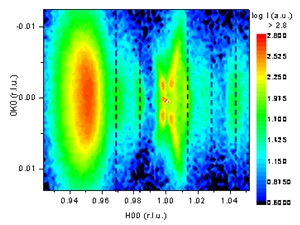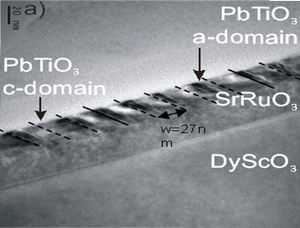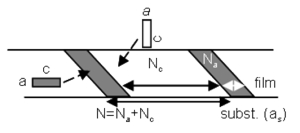(Nano)domain patterns in ferroelectric thin films

By A.H.G. Vlooswijk. G. Catalan and B. Noheda
In collaboration with: A. Janssens, G. Rijnders, D.H.A. Blank (U. Twente) ; S. Venkatesan, B. Kooi, J.T.M. de Hosson (U. Groningen)
Until recently, ferroelectricity was believed to disappear at the nanoscale; now, nano-ferroelectrics are being considered in numerous applications1. This renewed interest was partly fuelled by the observation of ferroelectric domains in films of a few unit cells thickness2, promising further size reduction of ferroelectric devices3. In thin films, self-patterned domain structures could be used in applications such as ferroelectric Random Access Memories (FeRAM’s), in which the storage density is increased by decreasing the domain size. However, controlling the size of these patterns and preserving their lateral coherency is still a challenge.
We have reported a step forward in the manipulation of ferroelectric domains by the growth of thin films with regular

self-patterned arrays of 90o domains only 6 nm wide5. This is the narrowest width for 90o domains in epitaxial ferroelectrics that preserves the film lateral coherence, independently of the substrate.
This has been achieved by growing ferroelectric PbTiO3 thin films on atomically flat, low-miscut, DyScO3 susbtrates. The lattice parametes of the susbtrate and the film match perfectly at the growth temperature, which allows to grow epitaxial films very much free of defects. While cooling down from the growth, the films undergo a ferroelectric phase transition and become tetragonal, with afilm<asubstrate<< cfilm . Significant mismatch between substrate and film then appears, which introduces tensile strain on the films.
The mismatch is about 1.3% at room temperature. In order to release this strain, the films break into domains with the polar (long) axis in (a-domain) and out-of plane (c-domain) (see Figure 1). In the absence of defects or steps on the substrate these

should be perfectly periodic. The volume fractions of the two types of domains is simply given by the lattice mismatch. We can therefore build periodic domain patterns with well-defined periodicities and large coherence lengths, such that can be observed by x-ray diffraction (see Figure 2).
The observed total periodicity is very small, ~27 nm, in films that are about 30 nm thick. The a-domains are about 20% of the total volume and have a very constant width of 6 nm (see Figure 3). We explain that this is the minimum possible width for an a-domain to be able to connect two adjacent c-domains in a coherent way and that this width only depends on the twin angle (α) and, thus, on the tetragonality (c/a) of the film. It needs to be noticed that this is not valid close to the interface where clampling effects are important. In general, the elastic properties of the substrate will play a very important role in deciding if horizontal or vertical coherence is energetically favorable6.
References
[1] Scott, J. F. Applications of modern ferroelectrics. Science 315, 954-959 (2007).
[2] Tybell, T., Ahn, C. H. and Triscone, J. M. Ferroelectricity in thin perovskite films. Applied Physics Letters 75, 856-858 (1999); Ahn, C. H., Rabe, K. M. and Triscone, J-M. Ferroelectricity at the nanoscale: Local polarization in oxide thin films and heterostructures. Science 303, 488-491 (2004); Streiffer, S. K. et al. Observation of nanoscale 180 degrees stripe domains in ferroelectric PbTiO$_3$ thin films. Physical Review Letters 89 (2002); Fong, D. D. et al. Ferroelectricity in ultrathin perovskite films. Science 304, 1650-1653 (2004).
[3] Schilling, A. et al., Ferroelectric domain periodicities in nanocolumns of single crystal barium titanate. Applied Physics Letters 89 (2006).
[4]Ying-Hao Chu et al. Nanoscale Domain Control in Multiferroic BiFeO3 Thin Films. Advanced Materials 18, 2307 (2006)
[5] A.H.G. Vlooswijk, B. Noheda, G. Catalan, A. Janssens, G. Rijnders, D.H.A. Blank, S. Venkatesan, B. Kooi, J.T.M. de Hosson, Applied Physics Letter 91 (11) ,112901 (2007)
[6] S. Venkatesan, B. Kooi, J.T.M. de Hosson, A.H.G. Vlooswijk, B. Noheda J. of Appl. Phys. 1 02 (10), 104105 ( 2007))
| Last modified: | 15 May 2024 3.33 p.m. |
